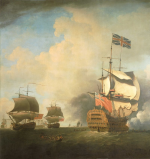- Reaction score
- 6,179
- Points
- 1,160
I guess we're really looking at slicing the same pie two different ways. You envision plugging all the personnel we currently have into deployable units to generate an expandable force. I on the other hand envision using that same number of troops in order to make a smaller number of Brigades sustainable in the field.That is the way that I see it. I'm not so sure about a light "division" my own napkin force has a mech division, a light high readiness brigade, a low readiness light bde, a separate med readiness mech bde, two arty bde, a CS bde and a CSS bde and a training structure within that pers envelope.
The advantage of my approach to my mind is that fielding Divisional-level formations takes a lot of "overhead" in supporting capabilities (including CSS support/tactical and strategic lift, volume of ammo, etc.) that you don't need if you're plugging Brigades into allied Divisions.
I see it as somewhat of a to-MAY-to/to-MAH-to difference as ultimately we're still looking at the same number of troops overall.
Do we get more out of earning brownie points with our European NATO partners or with the US? Are the Europeans really going to do us any great favours if we increase our NATO force commitment? In the event of a war with Russia (still much more unlikely than a conflict with China in my opinion) our contribution, even at a Divisional level, will be a relatively small part of the overall allied effort.@GR66 I agree that the mech bde has little usefulness for the Pacific. It's not meant for that but to earn us brownie points within NATO.
In a conflict with China however, as I mentioned in my previous post, the US will get much, much less assistance from their European NATO allies. That means any assistance they get from Canada will be much more greatly appreciated (and noticeable).
I agree that we're not a two war military like the US...but unlike our European allies we ARE an expeditionary military like the US. Our current expeditionary capabilities are lacking, but that is one capability that I believe the US would certainly appreciate us being able to provide.The key issue is that we are not a two war military like the US - we can do one. In that one war is Europe the div is the front line and everyone else the replacement and sustainment. If that war is Pacific then everyone else is the the lead and the mech division forms the core of replacement and sustainment. I haven't really given much consideration what the "rest" should look like (except in very broad strokes) because, quite frankly, the Pacific is in my mind more a navy and air force thing and I haven't seen anything in the way of a niche for our army there (except maybe our own coastal defence (and that includes Arctic). Effectively I've earmarked manpower, because I haven't forgotten about it, but haven't designed it.
Also agreed that the Pacific is much more likely to be a naval and air conflict, but there are certainly Army capabilities (AD, USMC-type capabilities, LRPF, etc.) that would be useful.
No arguments hereRegardless. I think our defence outputs should be considerably bigger than what they are for the current investment in treasure and manpower. What's missing is a plan for a "big event". Just to reiterate my thought process - I started in this game when we had nukes. I can't see defending this country with a handful of underequipped, understrength battle groups when things get serious. And I'm firmly convinced that they will get serious. Not today, not tomorrow, but they will.





